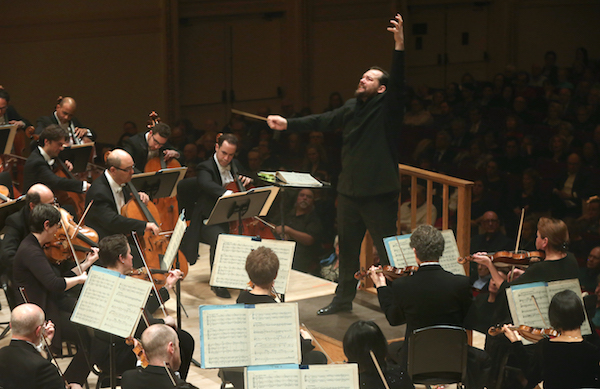Boston Symphony, Nelsons, and virtuosic Hardenberger bring out the beauty in Gruber, Mahler

Andris Nelsons conducted the Boston Symphony Orchestra at Carnegie Hall Monday night. Photo: Steve J. Sherman
The Boston Symphony Orchestra made its first season appearance of three Monday night at Carnegie Hall. The program, conducted by music director Andris Nelsons, was an unusual yet showy pairing of HK Gruber’s trumpet concerto, Aerial and Mahler’s Symphony No. 5.
Hakan Hardenberger was the soloist in Aerial, and his virtuosity was beyond impressive—he made what few trumpeters can do sound almost routine. And it was all in service to the music, which itself needs such greatness to realize its most beautiful moments.
What is strongest in Aerial is the way Gruber stretches the limits of the instrument in order to find new kinds of beauty. This quality is most dense in the first movement, “Done with the compass-Done with the chart!” (from Emily Dickinson), where Hardenberger held long tones while singing a second note through his horn, then changed the sung note to create cadences that were marvelous because of a simplicity that felt powerful and inevitable.
But the trumpeter, for whom the piece was written, seemed slightly wasted by the music, or else he could not make it all work. Aerial is full of brilliant moments that displayed Hardenberger’s musicality and made formal and structural sense, but just as often it veered off into passages that were internally illogical, so unrelated to the material Gruber had already established as to be disconcerting.
Accompanying the soloist, the BSO played with exquisite intonation and instrumental balance, but didn’t have a comfortable handle on the jazz and dance rhythms in the second movement, “Gone Dancing.” The performance reinforced the long-standing impression of the concerto that it is a frustrating, problematic work that depends too much on Hardenberger’s musical personality.
The performance of Mahler’s Fifth Symphony, after intermission, was superb. Nelsons made two crucial decisions that held it back from the very highest rank—in the first movement, he took a pause between the first and second sections, and most of the tension that had built up evaporated; and his approach to the Adagietto went against the type he had already established in the first two movements.
That approach was somber and also sober. Tempos in the first movement and in the Adagietto were toward the extreme edge of slow—in close company with Leonard Bernstein’s later interpretations but without any emotional exaggeration. It was as if Nelsons and the BSO presented Mahler as he wished to be seen, and let the composer speak for himself.
This was a Mahler Fifth with an emphasis on sonic and musical beauty, and the orchestra’s playing was indeed beautiful. Thomas Rolfs’ opening trumpet solo traversed an extraordinary distance from grimness to glowing pride in its few short measures, and the entire brass section played with expressive, powerful beauty throughout. The horn section was also outstanding as a whole, though James Sommerville’s playing in the Scherzo was not as characterful as ideal.
The orchestra’s sound was a Mahler sound, a fluid and chameleonic mix of bright, sour, and woody. The Adagietto was lovely, but it was there that Nelsons brought out mannered feelings—the extremely slow tempo made that almost inevitable—that felt out of place with the clear-thinking of the rest of the performance.
The resolution at the great climax in the Rondo-Finale was perfect on its own terms and came as the realization of every preceding note, from the opening D-sharp.
The BSO returns with conductor Thomas Adès and pianist Kirill Gerstein 8 p.m. March 20. carnegiehall.org






Posted Nov 20, 2018 at 8:35 pm by Allison
In that last sentence “…from the opening D-sharp.” The first note is a C-sharp.
Posted Nov 21, 2018 at 11:21 am by George Grella
For the trumpeter playing a B-flat instrument, it’s D#, same sounding pitch though
Posted Nov 21, 2018 at 2:26 pm by Christian
Someone who likes how Eschenbach conducts Bruckner would have liked Nelson’s Mahler yesterday.